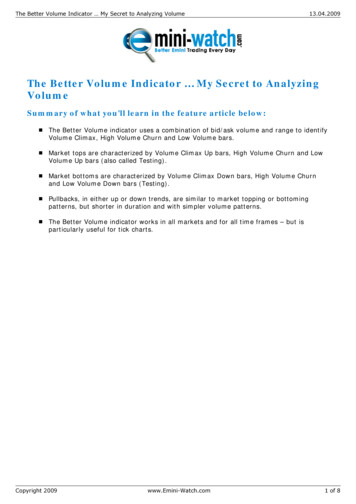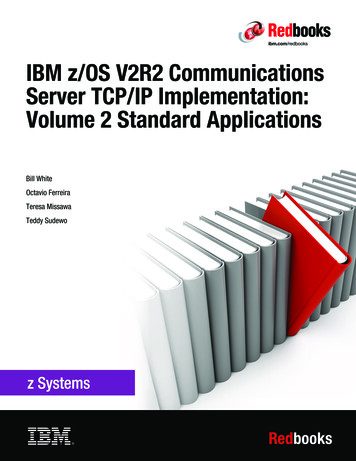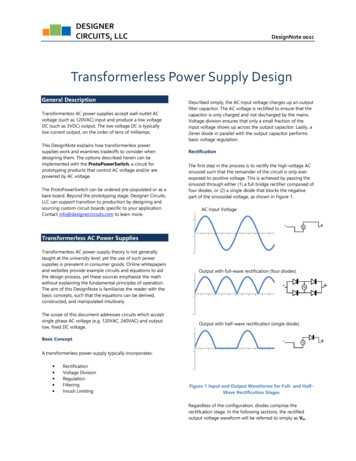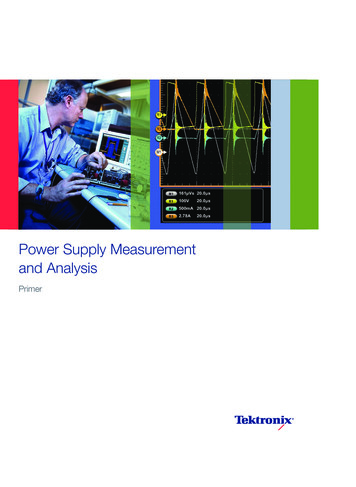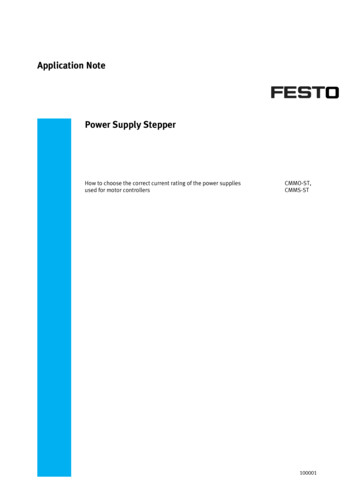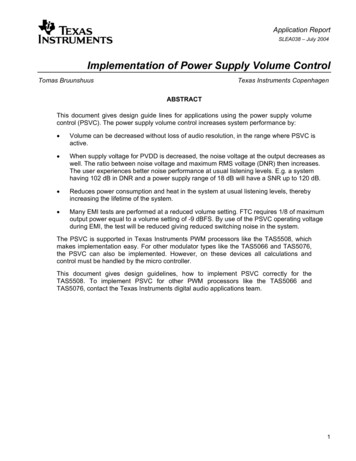
Transcription
Application ReportSLEA038 – July 2004Implementation of Power Supply Volume ControlTomas BruunshuusTexas Instruments CopenhagenABSTRACTThis document gives design guide lines for applications using the power supply volumecontrol (PSVC). The power supply volume control increases system performance by: Volume can be decreased without loss of audio resolution, in the range where PSVC isactive. When supply voltage for PVDD is decreased, the noise voltage at the output decreases aswell. The ratio between noise voltage and maximum RMS voltage (DNR) then increases.The user experiences better noise performance at usual listening levels. E.g. a systemhaving 102 dB in DNR and a power supply range of 18 dB will have a SNR up to 120 dB. Reduces power consumption and heat in the system at usual listening levels, therebyincreasing the lifetime of the system. Many EMI tests are performed at a reduced volume setting. FTC requires 1/8 of maximumoutput power equal to a volume setting of -9 dBFS. By use of the PSVC operating voltageduring EMI, the test will be reduced giving reduced switching noise in the system.The PSVC is supported in Texas Instruments PWM processors like the TAS5508, whichmakes implementation easy. For other modulator types like the TAS5066 and TAS5076,the PSVC can also be implemented. However, on these devices all calculations andcontrol must be handled by the micro controller.This document gives design guidelines, how to implement PSVC correctly for theTAS5508. To implement PSVC for other PWM processors like the TAS5066 andTAS5076, contact the Texas Instruments digital audio applications team.1
SLEA038Contents1Introduction .31.1 PSVC Advantages.31.2 PSVC Concept .32General Structure.52.1 Examples of Gain Settings .72.1.1 Gain Setting Within the PSU Range.72.1.2 Gain Setting Higher Than the PSU Range .72.1.3 Gain Setting Lower Than the PSU Range.72.2 Power Supply Control.82.3 TAS5508 PSVC PWM Output .92.4 Programming the TAS5508 for PSVC.103Power Supply Implementation.123.1 TAS5508 0% Duty Cycle Handling.123.2 Power Supply Sink / Source.134DC/DC Converter Application Example .154.1 Implementation.15References.16Figure 1.Figure 2.Figure 3.Figure 4.Figure 5.Figure 6.Figure 7.Figure 8.Figure 9.Figure 10.Figure 11.Figure 12.FiguresDigital and Power Supply Gain .4Resulting Gain .4Volume Calculation Flow Chart .6Control of the Power Supply .8PSVC PWM Pulse .9Configuration Using PWM .9PSVC Output of the TAS5508.10PSVC With Saturation .12PSVC With Shutdown .13Basic Schematic for a Buck Converter .13Buck Converter Using Synchronous Rectification .14Use of a Bleeder Resistor to Sink Current.14Table 1.Table 2.Table 3.TablesSystem Control Register 1 (0x03) .10PSVC Range Register (0xDF) .11General Control Register (0xE0) .112Implementation of Power Supply Volume Control
SLEA0381Introduction1.1PSVC AdvantagesUsing a combination of digital gain and power supply to the control volume setting gives severaladvantages: Volume can be decreased without loss of audio resolution, in the range where PSVC isactive. When supply voltage for PVDD is decreased, the noise voltage at the output decreases aswell. The ratio between noise voltage and maximum RMS voltage (DNR) then increases.The user experiences better noises performance at usual listening levels. E.g. a systemhaving 102 dB in DNR and a power supply range of 18 dB will have an SNR up to 120 dB. Reduces power consumption and heat in the system at usual listening levels. Therebyincreasing lifetime of the system. Many EMI tests are performed at reduced volume setting. FTC requires 1/8 of maximumoutput power equal to a volume setting of -9 dBFS. By use of PSVC, the operating voltageduring EMI test will be reduced, giving reduced switching noise in the system.With only a minimum extra complexity audio performance can be improved and EMI testsbecome easier to pass.1.2PSVC ConceptSpeaker output voltage can at be calculated as:VSPEAKER (t ) d (t ) VPSUWhere d is the duty cycle that varies according to the audio signal and VPSU is the power supplyvoltage. From this equation it can be seen that the output volume can be controlled from eitherthe duty cycle or the power supply voltage. Note that when the output volume level is calculatedin dB, the following formula is used:VSPEAKER (dB) d (dB ) VPSU (dB)Using this formula it becomes easier to calculate total output volume. The concept pf PSVC is tohave the power supply to control from 0 dBFS to e.g. -24 dBFS and then use digital gain tocontrol volume above 0 dBFS and below -24 dBFS. The lower crossover point (e.g. -24 dBFS)can be selected differently depending on the power supply configuration.Implementation of Power Supply Volume Control3
SLEA038Digital & Power Supply Gain (dB)Power Supply Volume -20-100102030Gain (dB)Digital GainFigure 1.Power Supply GainDigital and Power Supply GainFigure 1 shows gain settings for both digital circuits and a power supply at different desiredgains. The resulting gain (or volume level) is the two gains, digital and power supply gain, addedtogether. This is shown in Figure 2 according to the previous formula.Power Supply Volume Control60Resulting Gain d Gain (dB)Digital GainFigure 2.Power Supply GainDigital GainResulting GainThe resulting gain is linear to the desired gain, where the power supply controls the gain from-24 dBFS to 0 dBFS.4Implementation of Power Supply Volume Control
SLEA038Note that minimum power supply gain (lower crossover point of -24 dBFS) must be selecteddifferent depending on the power supply capability, e.g. -18 dBFS or -12 dBFS.2General StructureTo set the volume correctly, the volume setting must be split into a digital gain setting and apower supply gain setting. Care must be taken to get these calculations right. Especially thecalculations at the two crossover points can cause non linear volume control if not donecorrectly. The TAS5508 automatically calculates settings for digital gain and power supply gain.A flow chart to calculate volume settings is shown in Figure 3. The principle is to set the powersupply volume according to the channel having the highest volume setting and then recalculategain setting for the digital circuits. The TAS5508 uses a sequence based on this flow chart tocalculate gain settings for digital gain and power supply gain.Implementation of Power Supply Volume Control5
SLEA038Channel1 volumeChannel2 volume.Channel n volumeFind Channel with highestvolume setting - channel xCalculate PSU setting forchannel xHigherIs PSU settingwithin PSU rangeLowerWithinrangePSU volume 0 dBPSU volume min. dBCalculate digital gain as:Channel1 digital Channel1 volume - PSU volumeChannel2 digital Channel2 volume - PSU volume.Channel n digital Channel n volume - PSU volumeFigure 3.6Volume Calculation Flow ChartImplementation of Power Supply Volume Control
SLEA0382.1Examples of Gain SettingsThe following examples are for a three channel system. The power supply can be controlledfrom -18 dB to 0 dB.2.1.1 Gain Setting Within the PSU RangeSystem requirement settings:Channel1 volume -14 dBChannel2 volume -28 dBChannel3 volume -22 dBChannel 1 is found to have the highest volume setting of -14 dB. The PSU volume is then set to-14 dB.Digital gain is then calculated as:Channel1 digital -14 dB – (-)14 dB 0 dBChannel2 digital -28 dB – (-)14 dB -14 dBChannel3 digital -22 dB – (-)14 dB -8 dB2.1.2 Gain Setting Higher Than the PSU RangeSystem requirement settings:Channel1 volume -14 dBChannel2 volume 4 dBChannel3 volume -22 dBChannel 2 is found to have the highest volume setting of 4 dB. The PSU volume is then set to0 dB, which is highest setting for the power supply.Digital gain is then calculated as:Channel1 digital -14 dB – 0 dB -14 dBChannel2 digital 4 dB – 0 dB 4 dBChannel3 digital -22 dB – 0 dB -22 dB2.1.3 Gain Setting Lower Than the PSU RangeSystem requirement settings:Channel1 volume -28 dBChannel2 volume -28 dBImplementation of Power Supply Volume Control7
SLEA038Channel3 volume -22 dBChannel 3 is found to have the highest volume setting -22 dB. The PSU volume is then set to-18 dB, which is lowest setting for the power supply.Digital gain is then calculated as:Channel1 digital -28 dB – (-)18 dB -10 dBChannel2 digital -28 dB – (-)18 dB -10 dBChannel3 digital -22 dB – (-)18 dB -4 dB2.2Power Supply ControlThe output voltage of the power supply PVDD is controlled by adjusting the reference voltage.The control loop in the power supply uses this reference voltage to regulate the output. Whenthe reference voltage is changed, PVDD will change accordingly.PVDDFeed BackSMPS-1DCreferenceFigure 4.Control of the Power SupplyThe reference voltage must be controlled from the TAS5508. If the reference voltage is ananalog voltage that has to pass from the TAS5508 at the amplifier board to the power supplyboard, the output voltage of the power supply will be erroneous. The voltage may drop whencrossing from one board to the next. This makes the volume setting inaccurate. Also, if noise orhum is injected into the reference voltage, this noise will be coupled into the power supply outputand then into the speaker output.This is solved in the TAS5508 by using a PWM signal instead of an analog reference voltage.8Implementation of Power Supply Volume Control
SLEA038Lowest Power SupplyVoltage PulseMaximum Power SupplyVoltage PulseFigure 5.PSVC PWM PulseThe PSVC PWM pulse has a duty cycle corresponding to the power supply volume setting. Theadvantage is that all volume information is independent of the voltage level. This means that anyvoltage drop can be compensated by reclocking the PWM signal at the power supply board.PWM pulses are then converted to the analog reference voltage through a low-pass filter.PVDDFeed BackSMPS-1Reference100 nFFigure 6.1 kΩ10 kΩPSVC PWM1 uF74LVC126Configuration Using PWMThe PSVC PWM frequency must be above 20 kHz to insure that no audible leftovers from PSVCPWM are coupled into the speaker outputs.2.3TAS5508 PSVC PWM OutputWhen PSVC is enabled, the TAS5508 generates a PWM signal at a frequency of 44.1 kHz or48 kHz. The PWM frequency is synchronized to the LRCLK of the I2S.Implementation of Power Supply Volume Control9
SLEA038Lowest Power Supplyvoltage Pulse 120 out of2048Maximum Power SupplyVoltagePulse 1944 out of 2048Figure 7.PSVC Output of the TAS5508The output has a maximum duty cycle of 95% corresponding to 0 dBFS and a minimum dutycycle of 6% corresponding to -24-dB attenuation.Note that during start up, error recovery, and reset the duty cycle is 0%, 0 V. This can bechanged by programming system control register 1 (0x03).Table 1.D7System Control Register 1 (0x03)D6D5D4D3D2D1D0-------PWM High Pass Disabled1-------PWM High Pass Enabled-0------/Auto Clock Set-1------Manual C
This document gives design guide lines for applications using the power supply volume control (PSVC). The power supply volume control increases system performance by: Volume can be decreased without loss of audio resolution, in the range where PSVC is active. When supply voltage for PVDD is decreased, the noise voltage at the output decreases as well. The ratio between noise voltage .

